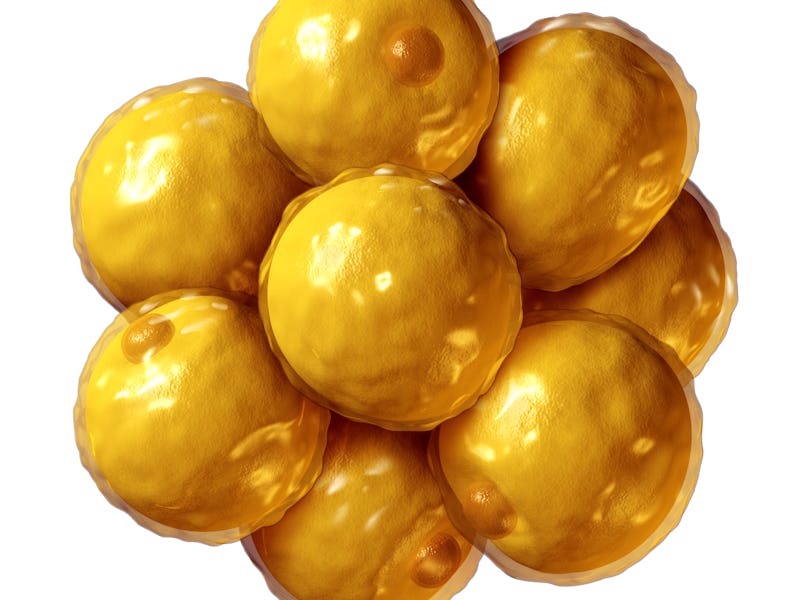Beige fat study hints at immune system and metabolism connection
When it comes to fat, there’s many shades of beige.

Fat comes in an earth-tone palette. Also called adipose tissue, fat comes in shades of white, brown, and beige.
Each of these colors results from the tissue’s molecular composition. Brown fat, which is the fat that keeps us warm as babies, gets its deeper hue from a high concentration of mitochondria, which is essentially the battery pack of the cell. The more mitochondria, the more energy-burning potential, the more heat generated by a cell.
White fat is at the other end of the spectrum, storing the extra calories in our bodies and thus doing a far better job at storing energy than burning it. Beige fat is somewhere in between — and this combination of white and brown fat’s qualities may confer therapeutic powers.
In a new study, researchers examine part of the mechanism that triggers the production of beige fat, finding a curious connection to the body’s immune system which could ultimately lead to fresh treatments for metabolic conditions, including obesity.
What’s new — In the study, researchers zoom in on an immune system signaling molecule called interleukin 25, or IL-25. When the researchers boosted the signal of this protein via a receptor called interleukin 17 B in white fat cells and then exposed the cells to cold and other stimuli, it, in turn, boosted the production of the neurotransmitter norepinephrine.
This neurotransmitter plays a role in beige fat production. By ramping its levels up in the fat cells, the white fat tissue started to go brown — becoming beige fat. In other words, some of the “good” stuff was made from the “bad” stuff.
“Our results show that interleukin-25 plays a key role in production of beige fat,” study co-author Zhonghan Yang says in a press release accompanying this study. Inverse repeatedly contacted the study’s authors for comment but they did not respond.
What’s more, they found that increasing the production of beige fat from white fat seemed to have therapeutic effects on mice at risk for obesity and related metabolic problems.
These results, Yang says, “point toward increasing interleukin-25 signaling as a potential treatment for obesity.”
Why it matters — Taken together, the results suggest there is a strong connection between the immune system and the body’s metabolism and fat production. While this is a mouse model, it’s a significant step toward better understanding beige fat in humans and how it could help treat metabolic conditions.
According to the CDC, in 2018 the obesity rate in the United States was more than 40 percent. Obesity is associated with a host of health complications, from decreased mobility and high blood pressure to diabetes and heart disease.
This study can also help us better understand what fat actually is, and grasp that it’s not something to be feared. There are different kinds of fat, and perhaps paradoxically, fat can help treat obesity.
How they did it — The researchers tested their theory in mice fed a high-fat diet that were also exposed to cold. They found that when they induced IL-25 signaling in these mice, they were protected from the adverse effects that can come with a high-fat diet — in other words, they avoided the health pitfalls that can come with too much fat being stored in the body instead of burnt off as energy.
Upping IL-25 signaling in the mice was associated with significantly less weight gain and improved glucose and insulin tolerance as compared to mice that did not have ramped-up IL-25 signaling.
What’s next — The big question not answered in this study is whether the findings might translate to human clinical trials. One next step is to test whether this immune system connection to beige fat production exists in humans. But, as is usually the case with mouse models, there’s still a ways to go before we jump from rodent to person.
It is also still unclear what role cold exposure may play in the browning process, but it adds to the evidence suggesting cold may play a role in both the immune system and metabolic conditions.
Abstract: Beige fat dissipates energy and functions as a defense against cold and obesity, but the mechanism for its development is unclear. We found that interleukin (IL)-25 signaling through its cognate receptor, IL-17 receptor B (IL-17RB), increased in adipose tissue after cold exposure and β3-adrenoceptor agonist stimulation. IL-25 induced beige fat formation in white adipose tissue (WAT) by releasing IL-4 and IL-13 and promoting alternative activation of macrophages that regulate innervation and up-regulate tyrosine hydroxylase (TH) up-regulation to produce more catecholamine including norepinephrine (NE). Blockade of IL-4Rα or depletion of macrophages with clodronate-loaded liposomes in vivo significantly impaired the beige fat formation in WAT. Mice fed with a high-fat diet (HFD) were protected from obesity and related metabolic disorders when given IL-25 through a process that involved the uncoupling protein 1 (UCP1)-mediated thermogenesis. In conclusion, the activation of IL-25 signaling in WAT may have therapeutic potential for controlling obesity and its associated metabolic disorders.
Editor’s note: A previous version of this article misstated that we only have brown fat as babies. We are pleased to correct the error.
This article was originally published on